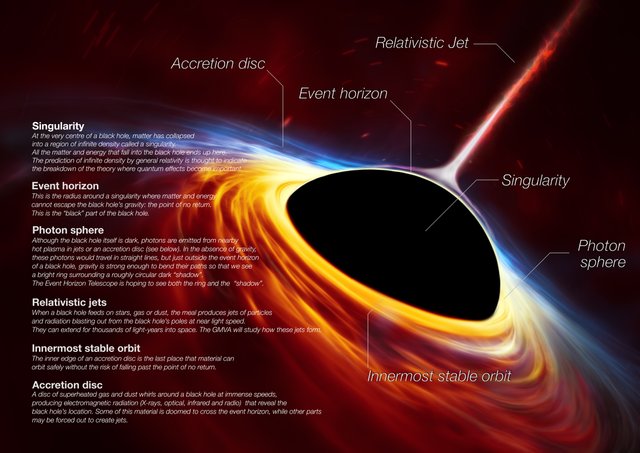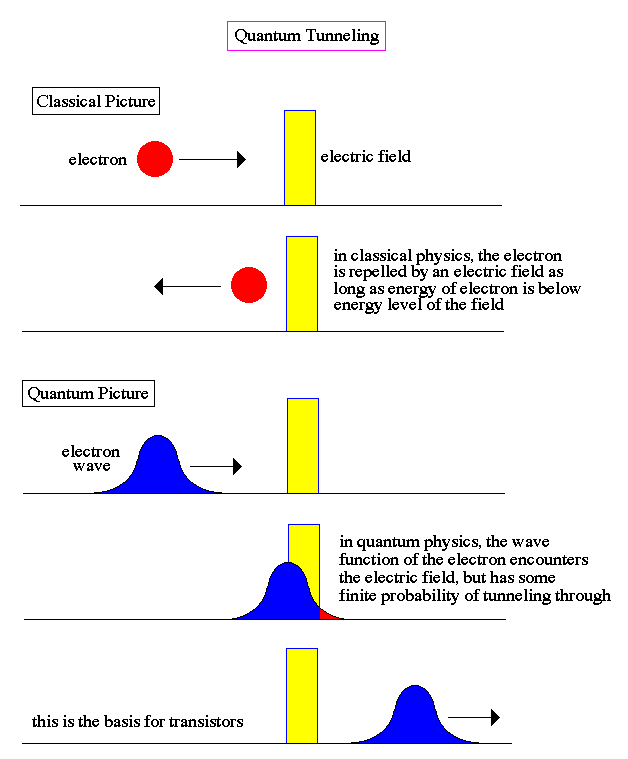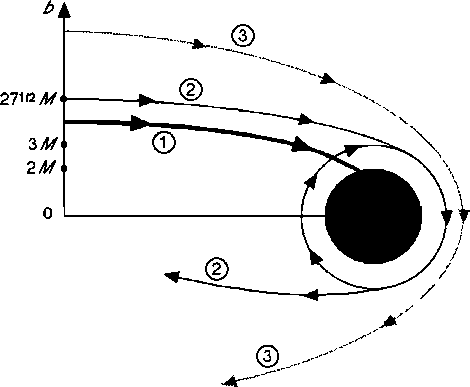How to Escape a Black Hole: Understanding the Event Horizon, Photon Sphere and Quantum Tunneling!
Introduction
Today we will be learning about some of the critical regions around a black hole and what they entail for the fate of both light and matter. These regions are known as the black hole’s event horizon and photon spheres.
Before we begin, here is a drawing I found depicting the defining characteristics of a black hole to help us visualize what we will be discussing:

What is the Event Horizon?
The Event Horizon defines the outer boundary at which it becomes impossible for matter to escape from the black hole. A simple explanation for this radius is by relating the gravitational potential energy to the maximum kinetic energy possible for the particle.
For the gravitational potential energy we can use the universal law of gravitation:
And the equation for kinetic energy is as follows:
Since we are interested in comparing the maximum kinetic energy to the potential energy we can use the speed of light in place of the velocity. While it is impossible for matter to ever travel at this speed we are using it as an upper bound for our calculation. By using the speed of light this equation now becomes:
Finally, we equate the two expressions and solve for the radius!
What is so amazing about this equation is that it is completely independent of the mass of the object falling into the black hole.
An important note is that even if light inside this region will never be able to escape the black hole. Additionally, depending on the angle the light is traveling it may be unable to escape from a black hole if it is inside of a larger region known as the photon sphere.
Deriving the fate of every photon requires some fancy maths and uses the concept of spacetime! What is important for the following section is the concept of like how gravity is pulling on matter the contraction of spacetime due to gravity catalyzes a similar reaction from photons.
Unfortunately, because of its complexity, I will only be discussing light approaching from the outside of the photon sphere. If anyone is interested, feel free to ask and I would love to do my best and explain it to you!
What Happens To Light Around the Photon Sphere?
One of the most exciting aspects of black holes is all of the possibilities of what happens to the light around the photon sphere.
There are three possible ways for light to approach a black hole all of which are fairly straight forward.
Narrowly missing the photon sphere
Traveling through the photon sphere
Hit the photon sphere perfectly on a tangent.
#1 Narrowly Missing the Photon Sphere!
If light nearly misses the event horizon it is curved around its edge of the black hole but will not fall into the black hole. This is called a precessing orbit and is responsible for the phenomenon of gravitational lensing which I discussed yesterday. In case you missed it here is the link!
#2 Traveling Through the Photon Sphere!
For the case of a photon which breaches the photon sphere is in what is known as a directly plunging orbit and is doomed to collapse into the black hole.
#3 Hitting the Photon Sphere Tangent!
My favorite scenario if when light hits the event horizon on a tangent. This is one of the rare cases where our understanding of General Relativity and Quantum Mechanics work hand in hand.
According to General Relativity the light should be indefinitely trapped in an orbit around the black hole. This means that the light to enter a stable, circular orbit around the black hole. When light orbits around a black hole it is considered circular since it is essentially the only body massive enough and close enough to warping spacetime and redirect photons.
However, this trajectory will not last indefinitely because of quantum mechanics! When a photon is orbiting a black hole it is considered to be in a knife-edge orbit and has the potential to either fall into or fly away with the slightest change. This is due to the uncertainty principle and quantum tunneling. According to quantum mechanics we can only know the probability of finding particles in a specific location. Via quantum tunneling at any moment a photon can simply be somewhere other than the photon sphere and if it exist there long enough will become less likely of returning there.

For the case of a knife edge orbit, at any moment the photon could be in a position other than along the photon sphere ! This also means that half the time a knife edge orbit will end with the photon plunging into the black hole and half of the time escaping from it!
Here is an image I found from one of my favorite books Exploring Black Holes: Introduction to General Relativity by Edwin Taylor and John Wheeler. Number 2 depicts a photon in a knife edge orbit where the photon ultimately escapes the black hole. Notice how it approaches the black hole from a radius greater than the photon sphere but is pulled onto it!

If you have any questions or know anything you would like to add feel free to do so in the comments! Or if you have any suggestions on how I can improve I would love to hear them!
If you enjoyed my content, please consider upvoting to help others find my content or even follow me if you would like to hear more!
Finally, I am always available at [email protected].
Work Cited:
https://sciencesprings.wordpress.com/tag/black-holes/
https://www.astronomyclub.xyz/black-holes-2/schwarzschild-maps-of-the-motion-of-light.html
http://abyss.uoregon.edu/~js/glossary/quantum_tunneling.html
Or you turn it into a temporary white hole using 40 nova bombs and then slipstream away before it collapses back into a black hole :P
@originalworks
The @OriginalWorks bot has determined this post by @thequantumknight to be original material and upvoted it!
To call @OriginalWorks, simply reply to any post with @originalworks or !originalworks in your message!